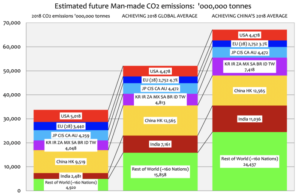by C. Rotter, February 21, 2020 in WUWT

Following the thinking of the late Prof David Mackay using “back of the envelope calculations”, this post makes estimates of the likely future growth in global CO2 emissions to put the efforts at CO2 emissions reduction in the Western World into the context of a probable and inevitable future for Global CO2 emissions.
Two scenarios are considered. They set the range of outcomes:
- The Underdeveloped world and India presently at a level of ~1.9tonnes/head/annum attain the global average level of CO2 emissions/head/annum of 2018: 4.46tonnes/head/annum. This results in Global CO2 emissions growing by 18.5Gigatonnes/annum to reach ~52Gigatonnes/annum. This level is close to the current CO2 emissions/head/annum in France.
- The Underdeveloped world and India eventually attain the level of CO2 emissions/head current in China: 6.78tonnes/head/annum. This level is also close to the average 2018 CO2 emissions/head/annum in the EU(28). This would result in Global CO2 emissions growing by ~33.5Gigatonnes/annum to reach ~67Gigatonnes/annum.
These values set a range of estimates and show how the inevitable CO2 emissions growth in the Developing World would swamp any savings made by Western nations in the name of controlling climate. This point was amply made by Berkley Professor Richard Muller in 2010, before he set up the BEST temperature record. His graph is shown below: this post just puts some more precise values on the extent that the Underdeveloped world will wholly overwhelm any efforts in the West to reduce Global CO2 emissions and thus attempt to influence Global temperature.
…

